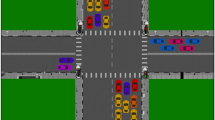Abstract
This work presents a novel traffic device (LaNPro) that avoids the stop of vehicles at junctions under low traffic conditions. To the best of our knowledge, this is the first smart traffic light designed for low traffic conditions. LaNPro is a security solution to preserve the physical integrity of drivers in countries with high social discrepancy. The server-side of the solution is deployed as a module of a smart traffic light, and it senses the presence of vehicles along the road through input devices (radars, cameras, road sensors, wireless communication) to assign the right of way. While any smart traffic light is able to manage low traffic intersections, we argue that they are not specialized devices to perform such task, and thus they may lack important optimizations. The main aggregated value of our approach is the ability to handle low traffic conditions, and that involves several challenges. Results show that our proposal may ensure the non-stop crossing of intersections having an expected traffic volume equal or less than λ = 0.10 vehicles per second, assuming intersections composed of 2, 3, or 4 lanes, road segments 200 m long, intersections 10 m wide, and vehicles 5 m long traveling at an average speed of μ = 40 km/h with standard deviation σ = 4 km/h.







Similar content being viewed by others
Notes
LaNPro: Late Night Programming.
Intelligent Transportation Systems.
Minimum speed is location-dependent, typically defined by the transit authority.
In Section 5.4 we demonstrate that LaNPro can manage the traversal of intersections up to λ = 0.1 vehicles per unit of time.
References
Koonce P, Rodegerdts L, Lee K, Quayle S, Beaird S, Braud C, Bonneson J, Tarnoff P, Urbanik T (2008) Traffic signal timing manual. http://ops.fhwa.dot.gov/arterial_mgmt/tstmanual.htm
Silva CM, Aquino AL, Meira W (2014) Design of roadside infrastructure for information dissemination in vehicular networks. In: 2014 IEEE network operations and management symposium (NOMS), pp 1–8. doi:10.1109/NOMS.2014.6838263
Harris JT (2005) Benefits of retiming traffic signals. Tech. rep., Institute of Transportation Engineers: annual meeting and exhibit compendium of technical papers
Liu Z (2007) A survey of intelligence methods in urban traffic signal control. IJCSNS Int J Comput Sci Netw Secur 7(7):105–112
Balan G, Luke S (2006) History-based traffic control. In: Proceedings of the fifth international joint conference on autonomous agents and multiagent systems. ACM, pp 616–621
Houli D, Zhiheng L, Yi Z (2010) Multiobjective reinforcement learning for traffic signal control using vehicular ad hoc network. EURASIP J Adv Signal Proc 2010:7
Helbing D, Lämmer S, Lebacque JP (2005) Self-organized control of irregular or perturbed network traffic. In: Optimal control and dynamic games. Springer, pp 239–274
Karakuzu C, Demirci O (2010) Fuzzy logic based smart traffic light simulator design and hardware implementation. Appl Soft Comput 10(1):66–73. doi:10.1016/j.asoc.2009.06.002
Niittymäki J, Pursula M (2000) Signal control using fuzzy logic. Fuzzy Sets Syst 116(1):11–22. doi:10.1016/S0165-0114(99)00034-2
Nakatsuyama M, Nagahashi H, Nishizuka N (1984) Fuzzy logic phase controller for traffic junctions in the one-way arterial road. In: Proceedings of the IFAC ninth triennial world congress. Pergamon Press, Oxford, pp 2865–2870
Pappis CP, Mamdani EH (1977) A fuzzy logic controller for a traffic junction. IEEE Trans Syst Man Cybern 7(10):707–717. doi:10.1109/TSMC.1977.4309605
Chiu S, Chand S (1993) Adaptive traffic signal control using fuzzy logic. In: Second IEEE international conference on fuzzy systems, 1993. IEEE, pp 1371–1376
Shihuang XDFJS (1992) A fuzzy controller of traffic systems and its neural network implementation [j]. Inf Control 2:001
McKenney D, White T (2013) Distributed and adaptive traffic signal control within a realistic traffic simulation. Eng Appl Artif Intell 26(1):574–583. doi:10.1016/j.engappai.2012.04.008
de Oliveira D, Bazzan A (2006) Traffic lights control with adaptive group formation based on swarm intelligence. In: Dorigo M, Gambardella L, Birattari M, Martinoli A, Poli R, Stutzle T (eds) Ant colony optimization and swarm intelligence, Lecture notes in computer science, vol 4150. Springer, Berlin Heidelberg, pp 520–521
García-Nieto J, Alba E, Olivera AC (2012) Swarm intelligence for traffic light scheduling: application to real urban areas. Eng Appl Artif Intell 25(2):274–283. doi:10.1016/j.engappai.2011.04.011. Special Section: Local Search Algorithms for Real-World Scheduling and Planning
Bonabeau E, Dorigo M, Theraulaz G (1999) Swarm intelligence: from natural to artificial systems. 1. Oxford University Press, Oxford
Theraulaz G, Bonabeau E, Denuebourg JN (1998) Response threshold reinforcements and division of labour in insect societies. Proc R Soc Lond Ser B: Biol Sci 265:327–332. doi:10.1098/rspb.1998.0299
Foy MD, Benekohal RF, Goldberg DE (1992) Signal timing determination using genetic algorithms. Transp Res Rec (1365)
Montana DJ, Czerwinski S (1996) Evolving control laws for a network of traffic signals. In: Proceedings of the 1st annual conference on genetic and evolutionary computation, GECCO ’96, pp 333–338. MIT Press, Cambridge
Kaelbling LP, Littman ML, Moore AW (1996) Reinforcement learning: a survey. arXiv preprint cs/9605103
Nagatani T, Hino Y (2014) Driving behavior and control in traffic system with two kinds of signals. Phys A: Stat Mech Appl 403(1):110–119. doi:10.1016/j.physa.2014.02.033
Hamza-Lup G, Hua K, Le M, Peng R (2008) Dynamic plan generation and real-time management techniques for traffic evacuation. IEEE Trans Intell Transp Syst 9(4):615–624. doi:10.1109/TITS.2008.2006738
Chun S, Zhang W, Yang Y, Mao G (2010) Analysis of access and connectivity probabilities in infrastructure-based vehicular relay networks. In: 2010 IEEE wireless communications and networking conference (WCNC), pp 1–6. doi:10.1109/WCNC.2010.5506271
Larson H (1982) Introduction to probability theory and statistical inference. Wiley, New York
McNeil DR (1968) A solution to the fixed-cycle traffic light problem for compound poisson arrivals. J Appl Probab 5(3): 624–635
Gerlough DL, Schuhl A (1955) Use of Poisson distribution in highway traffic. Eno Foundation for Highway Traffic Control
Acknowledgments
This work was partially funded by CNPq, FAPEMIG, FAPEAL, and InWeb.
Author information
Authors and Affiliations
Corresponding author
Additional information
Patent: BR 10 2013 027283 3.
Rights and permissions
About this article
Cite this article
Silva, C.M., Aquino, A.L.L. & Meira, W. Smart Traffic Light for Low Traffic Conditions. Mobile Netw Appl 20, 285–293 (2015). https://doi.org/10.1007/s11036-015-0571-x
Published:
Issue Date:
DOI: https://doi.org/10.1007/s11036-015-0571-x




